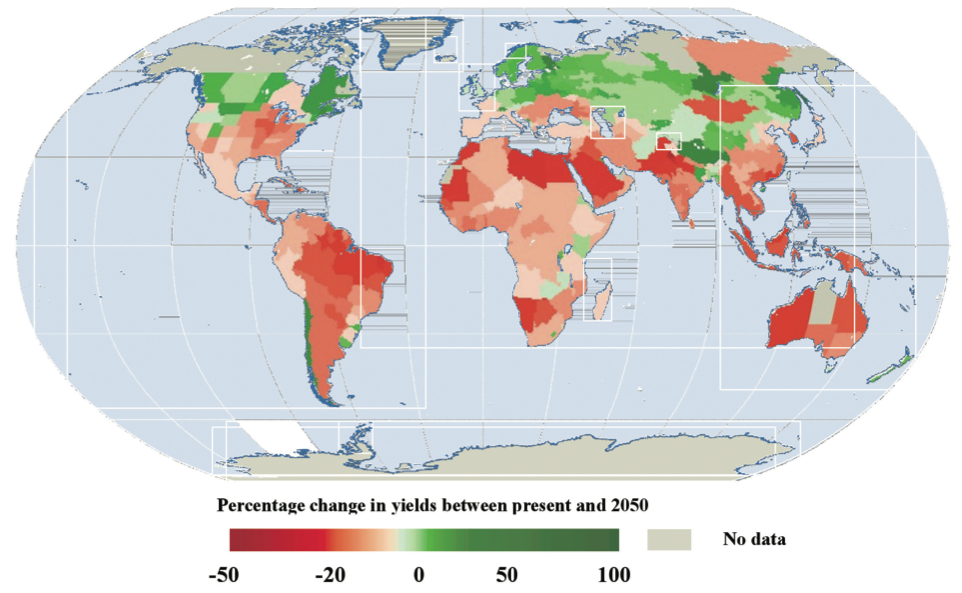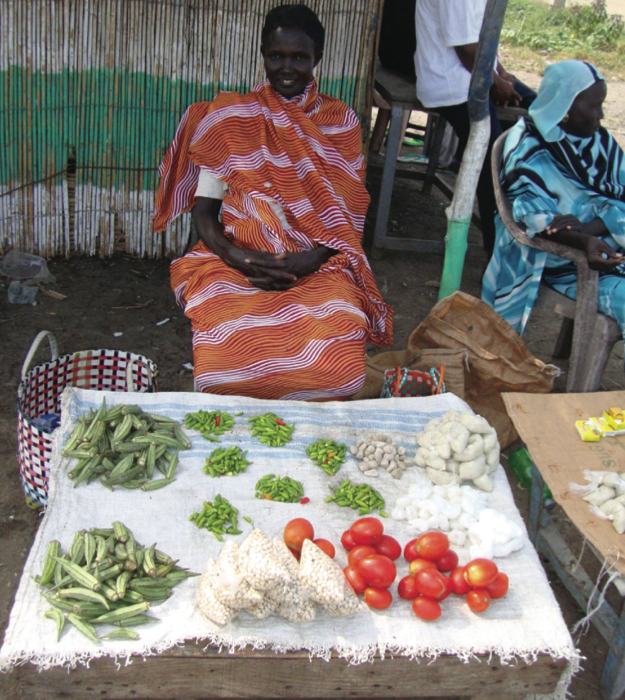Climate change, population and food security

Summary
It is widely recognised that climate change will impact negatively on food security and poverty, particularly in some countries in the developing world.
This paper, however, points out that population growth will likely have a bigger neg- ative impact on food security and poverty in some countries in Asia and sub-Saharan Africa.
The impact of climate change and population growth on food security and poverty in Timor-Leste (East Timor), a newly-independent country in South-East Asia, is discussed as an example.
Simulation modelling of the effects of warming temperatures in East Africa indicates that sorghum yields of small-holder farmers using little or no fertiliser will increase at least in the short term due to faster breakdown of organic matter and uptake of higher amounts of nitrogen from the soil.
The warming temperatures reduce yields only when higher levels of fertiliser are applied.
It is recognised that crop production is only one of the factors that affect food security and an example from South Sudan, the world’s youngest country, is used to show that social factors affect food supply in the market, not climate change or lack of available land or water.
The paper argues that research on climate change should continue, but that research to improve crop productivity with the present climate should not be disadvantaged if poverty reduction and food security targets are to be met.
Keywords: Crop production, East Africa, East Timor, fertiliser levels, global warming, sorghum, South Sudan, Timor-Leste
Glossary
C4 plants are species such as maize, sorghum and sugar cane with a pathway of photosynthesis that produces the four- carbon compound (hence the name) oxaloacetate, rather than a three-carbon sugar in C3 plants. The C4 pathway of photosynthesis is much more efficient than the C3 pathway chain.
As I begin to write this article, Australia is sweltering with high temperatures at levels not seen previously since records began, while China is freezing with cold temperatures not experienced for decades.
These extreme events are being attributed to climate change as climate scientists now are predicting that the incidence of extreme events is linked to anthropomorphic global warming with greater certainty than predicted by the Intergovernmental Panel on Climate Change in its fourth report (1).
It is the greater incidence of extreme events around the world that is convincing the general public that climate change is ‘real’ and that investment in mitigation and adaptation measures is worthwhile.
There is widespread consensus that one of the major consequences of global warming is the predicted decrease in crop yields in semiarid and subtropical regions of the world as a result of the speeding of crop development and a reduction in crop fecundity at higher temperatures, and the increased incidence of water shortage associated with reduced rainfall (2, 3, 4, 5).
Müller et al. (6, 7) calculated that most regions of the world would experience yield decreases by 2050 if the higher atmospheric carbon dioxide levels did not change yields, as several studies suggest (8, 9), particularly in crops, such as maize and sorghum, exhibiting the C4 pathway of photosynthesis (see Glossary) .
Figure 1 shows the projected percentage change in yields of 11 major crops (wheat, rice, maize, millet, field pea, sugar beet, sweet potato, soybean, peanut, sunflower and rapeseed/canola), showing significant yield reductions in sub-Saharan Africa, South Asia, North and South America and Australia (7).
Thus, global climate change raises concerns about food security and the vulnerability of particularly small-holder farmers to cope with climate change and adaptation to climate change (4, 6, 10, 11).
As it is generally recognised that small-holder farmers in the developing world are the persons most at risk from climate change (10), considerable aid and research resources are being channelled into research on the impact of climate change on food security and the adaptive capacity of vulnerable farmers.
However, all is not gloom and doom. Global warming is predicted to increase yields in more northerly latitudes where cold temperatures limit yields (Fig. 1).
Warmer seasons will enable winter-sown crops (e.g., winter wheat) to grow where only spring- sown crops (e.g., spring wheat) can be grown under current climates, higher- yielding crops such as maize will be able to supplant lower-yielding crops such as wheat in regions too cold for C4 crops or where it has to be grown under plastic for cobs to develop (12).
In a drying climate, livestock farmers will be able to switch from pastures to produce food and feed crops, in wetter regions where waterlogging currently limits crop yields (5, 13). Examples where studies suggest that climate change is not the major driver of food security are discussed in the following section.
Timor-Leste (East Timor) is a small island state in the Timor Sea just north of Australia. It gained its independence in 2002 after a period of conflict during which agricultural production and food security were compromised.
Australia and the International Agricultural Research Centres provided significant aid to the Ministry of Agriculture and Fisheries in Timor-Leste to re-establish agricultural production in the young island nation (14, 15).
An analysis of climate change by Molyneux et al. (16) indicated that temperatures were likely to rise by about 1.5°C, while rainfall was predicted to increase by about 10% across the island.
The authors conclude from simulation studies in Africa and India that yields of maize and peanut on Timor-Leste may decrease by 4% and 21%, respectively (2). The analysis by Cooper et al. (2) was conducted with nitrogen non-limiting.
A subsequent analysis of the effects of climate change on sorghum showed that with fertilizer rates used by small- holder farmers in Africa, namely 0 and 20 kg N ha-1, yields actually increased with temperature rises of 3°C and no change in rainfall (17).
The increase was observed despite a shortening of the growing period and the simulation results indicate that the higher temperatures induced a faster breakdown of organic matter in the soil and greater uptake of nitrogen by the sorghum (17).
As fertiliser is not used by farmers in Timor-Leste, it is likely that the climate change scenario for the island will result in increased yields, at least in the short term until the soil organic matter runs down.
While climate change may not result in a reduction in yield, population growth is likely to create a greater risk to the alleviation of poverty than climate change in Timor-Leste (16).
The current population is about 1.20 million with an annual growth rate of 2.4 % (18). By 2050 the population is expected to nearly treble to 2.5 to 3 million (18).
While Timor-Leste’s population growth rate is lower than many countries in East and West Africa, it is twice that of other countries in South-East Asia (18).
The four major food crops are rice, maize, cassava, and sweet potato. In 2011, 98,000 tonnes of rice, 31,000 tonnes of maize, 22,000 tonnes of cassava and 10,000 tonnes of sweet potato were produced by Timor-Leste farmers (19).
The four crops provide 1300 kcal/capita/day, 64% of the daily calorific intake from all sources, and 27 g/capita/day of protein, 47% of the daily protein intake (19).
To supplement the local production Timor-Leste imported 3,800 tonnes of rice and 2850 tonnes of maize in 2009 (19), sufficient to ensure that overall consumption at 2100 kcal/capita/day was above the minimum energy requirement of 2000 kcal/capita/day considered necessary for limited work.
However, consumption is unevenly spread within the population, with 23% of the population considered undernourished (19).
Malnutrition is particularly serious among children with about 47% of children under the age of five considered chronically malnourished (stunted) and 43% severely malnourished (20), suggesting that food supply is already insufficient to meet the current population.
With 37% of the population living on less than US$1.25/day (http://www.ausaid.gov.au/countries/e astasia/timor-leste/Pages/statistics-east- timor.aspx), the international measure of poverty, the opportunity to purchase food, particularly in rural areas, is limited.
Pockets of poverty in densely populated farming communities already exist. With the predicted population increase, the incidence of poverty and malnutrition is likely to increase unless food production, food imports and incomes increase.
Food security is not simply a function of food production, but is influenced by regional conflicts, changes in international trade agreements and policies, infectious diseases and other societal factors (11, 21).
For example, decades of civil war in Sudan have left the new nation of South Sudan with very limited supplies of food in the market place (Fig. 2), despite access to large areas of uncultivated land and water (River Nile).
As a result of the civil war, a generation of refugees living in neighbouring countries have lost their farming experience and lost initiative.
Additionally, the lack of training facilities and infrastructure such as roads and transport facilities makes inputs of fertiliser, insecticides and seed, difficult to obtain and produce difficult to market.
I do not wish to suggest that there should be no investment in research and development to enable farmers in the developing world to adapt to climate change, but that the investment should not be at the expense of current research and development aimed at improving yields and livelihoods.
In Timor-Leste, the successful introduction and adoption of improved cultivars of staple food crops after the period of food insecurity resulting from conflict, has resulted in increased household food security and produced a surplus for sale in the market, often for the first time (14).
This was the result of a targeted research and development program funded by the Australian and Timorese governments aimed at increasing crop production and food security (15, 22).
Furthermore, studies of timely and improved management of crops in eastern and southern Africa, including the use of fertilisers, have shown that crop production can be increased much more than the increases induced by global warming with low levels of fertiliser application (17).
Overcoming malnutrition and food insecurity, particularly in South Asia and sub-Saharan Africa, are primary challenges for agriculture in the 21st century.
Climate change, particularly the incidence of extreme events, will have an impact on malnutrition and food security, but in regions with high population growth and low adaptive capacity such as Timor-Leste and sub-Saharan Africa, governments and agencies will first need to strengthen the adaptive capacity of farmers through improved yields and productivity.
Conclusions
The impact of climate change on food security may be less than that of popu- lation rise and lack of experience in some countries recovering from con- flict such as Timor-Leste and South Sudan, and countries in sub-Saharan Africa with high rates of population increase.
Further, warming temperatures may result in increased crop yields for small-holder farmers using little or no fertilisers on nutrient-poor soils. Continuing emphasis on improved cultivars management infra- structure and marketing will be required to ensure food security as the population rises to 9 billion by 2050.
References
1. Christensen, JH, Hewitson, B, Busuioc, A, Chen, A, Gao, X, Held, I, Jones, R, Kolli, RK, Kwon, W-T, Laprise, R, Magaña Rueda, V, Mearns, L, Menéndez, C.G, Räisänen, J, Rinke, A, Sarr, A & Whetto, P (2007) Regional Climate Projections. In: Climate Change 2007: The Physical Science Basis. Contribution of Working Group I to the Fourth Assessment Report of the Intergovernmental Panel on Climate Change (eds., S Solomon, D Qin, M Manning, M Marquis, KB Averyt, M Tignor & HL Mille, Cambridge University Press, Cambridge, UK, and New York, NY, USA. ISBN 978-0521-88009-1.
2. Cooper, P, Rao, KPC, Singh, P, Dimes, J, Traore, PS, Dixit, P, & Twomlow, SJ (2009) Farming with current and future climate risk: Advancing a “Hypothesis of Hope” for rainfed agriculture in the semi-arid tropics. Journal of SAT Agricultural Research 7 (ejournal. icrisat.org /aespaperv7).
3. Asseng, S, Foster, I & Turner, NC (2011) The impact of temperature variability on wheat yields. Global Change Biology 21, 997-1012.
4. Yadav, SS, Redden, RJ, Hatfield JL, Lotze- Campen, H & Hall, AE (2011) Crop Adaptation to Climate Change. Chichester, UK, Wiley/Blackwell. ISBN 978-0-8138-2020-3.
5. Turner, NC & Meyer, R (2011) Synthesis of regional impacts and global agricultural adjustments. In: Crop Adaptation to Climate Change (eds., SS Yadav, RJ Redden, JL Hatfield, H Lotze-Campen, & AE Hall). pp. 156-166. Chichester, UK, Wiley/ Blackwell. ISBN 978-0- 8138-2020-3.
6. Müller, C, Bondeau, A, Popp, A, Waha, K & Fader, M (2009) Climate Change Impacts on Agricultural Yields. Background note for the World Development Report 2010 (World Bank, 2009).
7. World Bank (2010) World Development Report 2010, Development and Climate Change. Washington, DC, The World Bank. ISBN 978-0-8213-7987-5.
8. Cure, J.D., Acock, B. 2186. Crop responses to carbon dioxide doubling: a literature survey. Agricultural and Forest Meteorology 38, 127-45.
9. Long, SP, Ainsworth, EA, Leakey, ADB, Nösberger, J, & Ort, DR (2006) Food for thought: Lower-than-expected crop yield simulation with rising CO2 concentrations. Science 313, 2120-21.
10. Cooper, PJM, Dimes, J, Rao, KPC, Shapiro, B, Shiferaw, B & Twomlow, S (2008) Coping better with current climatic variability in the rain-fed farming systems of sub-Saharan Africa: An essential first step in adapting to future cli- mate change? Agricultural Ecosystems and Environment 126, 24–35.
11. Lotze-Campen, H, Müller, C, Popp, A, & Füssel, H-M (2012) Food security in a changing climate. In: Climate Change, Justice and Sustainability: Linking Climate and Development Policy (eds., O Edenhofer& J Wallacher). pp 33-43, Dordrecht, Springer Netherlands. ISBN 978-94-007-4539-1.
12. Zhou, L-M, Jin, S-L, Liu, C-A, Xiong, Y-C, Si, JT, Li, X-G, Gan, Y-T, & Li, F-M (2012) Ridge-furrow and plastic-mulching tillage enhances maize–soil interactions: Opportunities and challenges in a semiarid agroecosys- tem. Field Crops Research 126: 181-8.
13. Turner, NC, Molyneux, N, Yang, S, Xiong, Y-C, & Siddique, KHM (2011) Climate change in south-west Australia and north-west China: challenges and opportunities for crop produc- tion. Crop and Pasture Science 62, 445-56.
14. Borges, LF, do Rosario Ferreira, A, da Silva, D, Williams, R, Andersen, R, Dalley, A, Monaghan, B, Nesbitt, H, & Erskine, W (2009) Improving food security through agricultural research and development in Timor-Leste: a country emerging from conflict. Food Security 1, 403-12.
15. Da Costa, H, Piggin, C, Fox, J, & da Cruz, CJ (2003) Agriculture: New directions for a new nation – East Timor (Timor-Leste). In: Proceedings of a workshop 1-3 October, Dili, East Timor. Canberra, Australian Centre for International Agricultural Research, Proceedings No. 113.
16. Molyneux, N, Rangel da Cruz, G, Williams, RL, Andersen, R, & Turner, NC (2012) Climate change and population growth in Timor Leste: implications for food security. Ambio 41, 823- 40.
17. Turner, NC & Rao, KPC (2013) Simulation analysis of factors affecting sorghum yield at selected sites in eastern and southern Africa, with emphasis on increasing temperatures. Agricultural Systems (in press).
18. Population Reference Bureau (2013) http://www.prb.org/Publications/Datasheets/2 012/ (Accessed 7 May 2013).
19. FAOSTAT (2013) http://faostat.fao.org/. Accessed 7 May 2013.
20. World Food Programme (2005) Food inse- curity and vulnerability analysis Timor Leste. VAM unit. Dili, Timor Leste, The United Nations World Food Programme. 2005 http://documents.wfp.org/stellent/groups/publ ic/documents/vam/wfp067434.pdf. (Accessed 20 November 2010)
21. Easterling, WE, Aggarwal, PK, Batima, P, Brander, KM, Erda, L, Howden, SM, Kirilenko, A, Morton, J, Soussana, J-F, Schmidhuber, J, & Tubiello, FN (2007) Food, fibre and forest products. In: Climate Change 2007: Impacts, Adaptation and vulnerability. Contribution of Working Group II to the Fourth Assessment Report of the Intergovernmental Panel on Climate Change (eds., ML Parry, OF Canziani, JP Palutikof, PJ van der Linden & CE Hanson). pp. 273–313, Cambridge, UK, and New York, NY, Cambridge University Press. IBSN 978- 0521-88010-7.
22. Seeds of Life (2008) Annual Research Report, 2007. Dili, Timor-Leste, Ministry of Agriculture and Fisheries.
Download pdfFigures

Figure 1. Percentage change in yields of 11 major crops (field pea, maize, millet, peanut, rapeseed (canola), rice, soybean, sugar beet, sunflower, sweet potato, wheat) between 1996-2005 and 2046-2055. The values are the means of three emission scenarios across five global climate models assuming no CO2 fertilisation (6, 7).

Figure 2. Stall in the market in Melut, South Sudan at the end of the wet season in November 2012 showing small amounts of tomatoes, ochra, chillies, garlic, dried beans and salt for sale. Other stall-holders were selling dried fish, onions, pumpkin and limes (the only fresh fruit available). Photo by Neil Turner.

